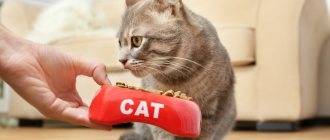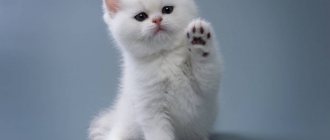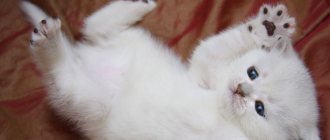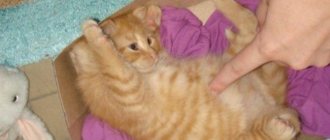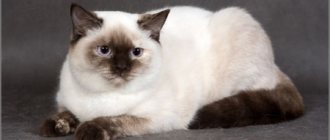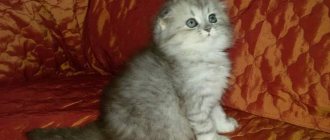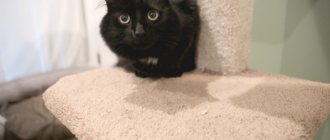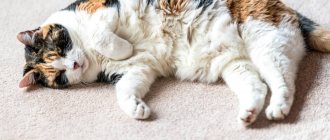Surprisingly, many owners may not even realize that their furry pets have weight problems. Often well-fed cats look very cute, and their special interest in food is easily justified by the fact that they simply love to eat.
However, excess weight sooner or later affects the health of the pet. To prevent this from happening, you need to know what signs indicate excess weight and what to do if your cat is obese. Specialists from a veterinary clinic in Moscow talk about everything in more detail.
Read in this article:
Common causes of obesity Signs of an overweight cat Why is obesity dangerous? Consequences of excess weight What to do if your cat is obese? Treatment of obesity in cats Useful tips to help your pet
Breed characteristics
Some breeds have a fold in the abdominal area their entire life. And, by the way, there is nothing reprehensible in this, since natural affiliation simply obliges you to “possess” a fat tail.
Do not be upset if the skin hangs on the belly of a cat of the following breeds: Canadian Sphynx, Pixie-Bob, Bengal, Scottish Straight, Scottish Shorthair. The reasons for the presence of loose skin in pets of these breeds are unknown. Probably, the fat layer should protect short-haired and hairless individuals from the cold, and for others, the fat tail should protect the abdominal organs from injury during fights.
Important! You should not try to reduce a saggy belly by starving your pet. With such a diet, the skin will not go anywhere, but, on the contrary, will become even more noticeable on a body that is too thin
Diagnostics and therapy
To make a diagnosis, blood, urine and feces are examined, ultrasound and x-rays are done. During the examination, the veterinarian palpates and listens to the peritoneum. Depending on the results that explain why the cat has a hard stomach, the doctor decides what to do to normalize his condition.
Help with non-dangerous causes of bloating
Flatulence caused by poor nutrition can be eliminated by adjusting the diet. A ban is imposed on any products that increase gas formation (legumes, flour, fresh vegetables). Remember that milk is contraindicated for adult animals, as they develop lactose intolerance. To normalize intestinal function, your veterinarian may recommend a course of probiotics.
Treatment
Treatment directly depends on the cause of bloating:
- Obesity requires a review of the pet's diet, a change in the frequency of feeding, as well as encouraging the cat to lead an active lifestyle;
- Pregnancy , of course, is not a disease and does not require treatment;
- If a cat has flatulence , then it is necessary to analyze its diet; it is possible to use a dietary diet; espumizan is used as symptomatic therapy;
- Viral diseases require specific treatment prescribed by a doctor;
- If a neoplasm is suspected, one type of biopsy is necessarily performed to identify the type of tumor, based on the results of which surgical or conservative treatment (chemotherapy) is prescribed;
- Heart diseases require special treatment depending on the type of disease and the stage of developed heart failure;
- Liver diseases are treated symptomatically and by following a strict diet;
- Kidney diseases , unfortunately, are mostly incurable (except for acute kidney injury); in this situation, only supportive treatment is used;
- For coprostasis , a cleansing enema or even surgical intervention is performed (in case of intestinal overdistension, lack of motility, and other pathologies), a diet analysis is also required, and sometimes oral laxatives are prescribed;
- Injuries most often require surgery;
- For pyometra in cats, only surgical treatment is used;
- Helminthic infestation is treated by using a course of anthelmintic drugs.
If a prompt visit to the veterinarian is not possible
If it is impossible to immediately take your pet to the veterinarian, and the cat’s stomach is swollen, then the algorithm of actions is as follows:
- Do not panic. Cats sense the owner’s stress very well and may also become nervous from increased attention, which can negatively affect their condition.
- Note the general well-being of your pet. Record and count the animal's respiratory rate per minute. Does your pet breathe from its belly? How does he sleep - as usual or only on his stomach? Is your appetite still there? What kind of chair does he have? Answering all these questions will help your veterinarian quickly make a diagnosis and prescribe treatment.
- Under no circumstances should you carry a cat in your arms; explain this to your children. Careless movements can aggravate the pet's condition, especially if the stomach is swollen as a result of injury or internal damage.
What can you do at home?
In continuation of the previous paragraph, you can add:
- If your cat's stomach and sides swell quickly, you can try applying a cold compress. Under no circumstances should you warm such a belly!
- The pet must be isolated from other cats, as this condition may be a sign of a dangerous viral infection.
Diagnostics
Diagnosis of bloating must be comprehensive and include blood tests (general and biochemical), urine, abdominal ultrasound and x-rays. In some cases, especially if neoplasms are suspected, a CT scan is recommended.
The following are the primary diagnostic methods, depending on the suspicion of various causes of bloating:
- Obesity – weighing the pet, analyzing the diet, palpation;
- Pregnancy - ultrasound of the abdominal cavity;
- Flatulence - diet analysis, abdominal ultrasound;
- Viral disease - specific virological tests (PCR test of blood and effusion);
- Neoplasm – ultrasound of the abdominal cavity, plain X-ray in three projections, CT in the “oncology search” mode;
- Heart diseases – cardiac ECHO;
- Liver diseases - general and biochemical blood tests, ultrasound of the abdominal cavity;
- Kidney diseases - general and biochemical blood tests, abdominal ultrasound, urinalysis;
- Coprostasis – abdominal x-ray;
- Injuries – ultrasound of the abdominal cavity;
- Pyometra - ultrasound of the abdominal cavity;
- Helminthic infestation - stool analysis.
Causes
Hypoalbuminemia
- This is a decrease in the level of albumin in the blood serum. Animals obtain albumin from their diet, and it is also produced in the liver. The kidneys prevent the excretion of albumin in the urine, thereby maintaining its concentration in the blood plasma. For proper absorption of albumin, normal functioning of the gastrointestinal tract is necessary. Albumin is responsible for the colloidal osmotic pressure of the blood; it is an important factor in the regulation of water exchange between the blood plasma and the intestines. A decrease in albumin levels (usually below 1.5 g/dL) results in a pressure gradient that forces fluid out of the blood vessels, leading to ascites.
Protein-losing nephropathy
. Disease of the glomeruli (filtration system), in which protein can be excreted in the urine, leads to a severe decrease in the level of albumin in the blood plasma. This condition can develop against the background of infections, immune, neoplastic diseases and as idiopathic.
Gastrointestinal diseases,
which interfere with the absorption of albumin. If albumin is not absorbed, expect a drop in blood levels. This happens with some diseases, such as gastrointestinal lymphoma, inflammatory bowel disease and dilation of the lumen of the lymphatic vessels in the intestine (lymphangiectasia).
Severe liver diseases
can provoke ascites with reduced albumin production, for example, severe hepatitis and cirrhosis.
Obstructive reasons.
Blockage of blood vessels in the abdominal cavity can lead to ascites. As a result of this blockage, fluid can leak from the veins or lymphatic vessels into the peritoneal (abdominal) cavity, depending on their location.
Blocked blood vessels
carrying blood from the liver to the heart (obstruction of the hepatic veins) can cause chronic ascites. This occurs in right ventricular heart failure, when the heart is unable to cope with venous blood that returns from the liver.
Right ventricular heart failure
. Ascites can occur during the early stages of heart disease, lung disease, or heartworm infection (dirofilariasis).
Abdominal formations
. Tumors, abscesses or cysts of the abdominal organs can cause ascites. They can break through and provoke acute ascites. Hemangiosarcoma is most prone to rupture and bleeding. Other formations may put pressure on or cause blockage of blood and lymphatic vessels, leading to chronic, slow-growing ascites.
Injury.
Bleeding may be due to a ruptured spleen; rupture of the gallbladder can provoke bile leakage, bile peritonitis; Trauma to the urinary tract (kidneys, ureters, bladder, urethra) can cause urine to leak, resulting in urine pooling in the abdomen.
Peritonitis
is an inflammation of the inner lining of the abdominal cavity. With such inflammation, different volumes of fluid of a very specific nature can be formed. Feline infectious peritonitis (FIP) is the most common cause. In addition, peritonitis can occur with gastrointestinal disorders (stomach, small and large intestines) or perforation, which requires immediate surgical intervention.
Ascites with accumulation of blood may be due to bleeding
due to various diseases (poisoning, metabolic disorders, heredity, cancer).
Diseases of the lymphatic system
may cause accumulation of lymph in the abdominal cavity. Blockage of lymphatic vessels due to tumors and injuries is common.
Signs of pathology
A cat's enlarged belly should be the reason for an unscheduled visit to the veterinarian. Sometimes, if the outflow of urine is disrupted or the intestines are blocked, a timely operation can save the life of a pet.
Why do certain pathologies develop if, in the opinion of the owners, the animal is well cared for? The causes of the development of diseases accompanied by enlargement of the peritoneum are:
- poor nutrition, lack of animal access to water;
- non-compliance with the schedule of vaccination and anthelmintic measures;
- peritoneal injuries;
- development of chronic diseases of internal organs.
There are a number of symptoms, the occurrence of which requires urgent consultation with a veterinarian. These include:
- diarrhea;
- vomit;
- apathy;
- increase in body temperature (hot, dry nose and ears);
- lack of appetite;
- the presence of blood, parasites and their eggs in the stool or urine.
Symptoms indicating illness
In addition to the duration of the bloating, it is important to consider any warning signs. Possible pathology is indicated by:
- inflammation, yellowing or blue discoloration of mucous membranes;
- too rapid enlargement of the peritoneum or sudden weight loss;
- frequent vomiting, diarrhea, or lack of bowel movements for more than 2 days in a row;
- lethargy and fever;
- pain when emptying the bowel or bladder;
- dullness and hair loss;
- foam, blood or parasites found in vomit and feces;
- increased thirst and loss of appetite;
- profuse drooling;
- severe pain in the abdominal area upon palpation.
If a pregnant cat's swollen belly does not return to normal within 1.5 days after birth, call a veterinarian. This condition is typical for unfinished labor. The stuck fetus will have to be removed surgically.
What is a cat's fat tail?
A cat's fat tail is scientifically called a “primordial pouch,” which means a genetic tendency in some cat breeds to form a fold of skin on the abdomen, between the hind legs.
A small hanging tail is considered normal for cats if it is elastic, soft to the touch, does not cause pain and its size does not exceed 5 cm.
In felinology, there are several theories that explain this anatomical feature in cats:
- The inguinal skin fold is a “depot” for fat deposits, which are consumed during prolonged fasting of a cat, which allows animals to survive in the most difficult circumstances. Fat deposits in cats are especially noticeable during the winter cold.
- The fat tail acts as a repository of excess elastic skin, which is actively used when jumping high, long, while climbing trees or when entering narrow crevices, when the cat needs to stretch out “in line” to get to the desired place.
- A hanging belly in cats is an additional means of protecting internal organs during fights and fights with relatives. Cats tend to deliver powerful blows to the enemy with their hind legs, and an additional layer of skin will protect the vulnerable belly from damage to internal organs.
All domestic and wild cats have a fat tail, but in some it is more pronounced due to breed or physiological characteristics, in others it is less pronounced.
In spring and summer, the size of the saggy tummy in cats is significantly reduced, and in late autumn and winter the fat tail grows again.
Why does the cat have a fat belly?
Tumors of the digestive tract can only be treated in a mild form. Malignant tumors are treated with surgery and chemotherapy. Unfortunately, the prognosis for animals with this diagnosis is very poor.
Just like people, pets have different body types and reasons that determine whether fat deposits will accumulate on the cat's belly or in other parts of the body. As we mentioned earlier, some cats have droopy bellies while others have wider bellies. This largely depends on conformation and race.
Body features are described by terms that characterize body types: loose (rough), rough, strong, dry. In this case, for example, the coarse type is characterized by slower muscles and a slower metabolism, and in such a cat, belly fat will accumulate more under the skin and sag significantly. The rough type is distinguished by dense skin and a highly developed skeleton; in such cats it is often evenly rounded, including on the stomach.
Fat can accumulate in the subcutaneous tissue, and soft, fluffy bags seem to form in the lower abdomen, closer to the hips, where the skin fold is located. Many owners are afraid of their appearance, but this is the most common area for fat accumulation in cats.
What to do:
- in all cases of abdominal enlargement, it is necessary to consult a doctor, regardless of the age of the animal - there are no options for “it will resolve on its own”!
– the faster the belly enlarges, the more urgent it should be to see a doctor. If there is a simultaneous significant deterioration in your health, you must go immediately to the clinic, where an ultrasound/X-ray and, if necessary, surgery can be performed.
– to independently monitor the amount of fluid in the abdominal cavity, you can use weighing + measuring the volume of the abdomen with a centimeter tape. Nevertheless, primary importance when choosing treatment tactics is given to the general condition of the animal and the degree of tension in the abdominal wall, and not to weight/volume.
Can ascites in cats be treated or not?
Treatment of ascites is carried out comprehensively. Therapy is aimed at eliminating the underlying disease, alleviating pain symptoms and strengthening the immune system.
To reduce the amount of fluid in the abdominal cavity, laxatives and diuretics (Furosemide, Temisal) are indicated.
To stabilize the functioning of the cardiovascular system, drugs such as Olitorizide, Strophanthin, Digitoxin, Cardiovalen are necessarily prescribed.
If there is an infection in the body, antibiotic therapy using drugs from a number of cephalosporins is indicated.
To strengthen the walls of blood vessels and reduce their permeability, the veterinarian prescribes intravenous solutions of calcium chloride (10%).
To pump out the fluid, a puncture is done when the veterinarian pierces the abdominal wall. The procedure is performed at least twice a week. In this case, the removal of ascitic fluid must be compensated by reinfusion of ascitic transudate or administration of an albumin solution. These procedures provide a chance for additional remission and prolongation of the animal’s life.
The course of treatment depends on the condition of the animal and the amount of fluid. This is a long process that must continue until the clinical signs of dropsy completely disappear.
As for the prognosis, with adequate and, most importantly, timely therapy, it is favorable. If you do not seek help from a specialist in time, the volume of fluid will continue to increase, and this is fraught with pressure on the internal organs and disruption of their functions.
Symptoms of ascites
The first and most obvious signs of ascites are the following symptoms:
- swollen, tight stomach (“bulging” sides);
- poor appetite (sometimes complete refusal to eat);
- flatulence, constipation, diarrhea;
- vomiting (most often with saliva);
- depressed mood (anxiety, sadness, apathy, etc.) due to abdominal pain;
- heavy breathing (rapid breathing, with wheezing, groaning, coughing, etc.);
- the cat tries to lie on its side;
- caution in movements (slow gait, uncertain steps, etc.);
- refusal to play and fatigue;
- weakness (fainting is also possible).
Some owners may mistake dropsy for the first signs of pregnancy (in cats), helminthic infestation, or flatulence. To make sure that it is definitely not gases or a fetus, it is enough to take the sick cat in your arms. In an animal in an upright position, the fluid will flow into the lower abdomen. As soon as you place the cat on the floor, the water will again be distributed throughout the abdomen.
Photo gallery: some signs of ascites in cats
With ascites, the cat's stomach "swells" A sick cat may become apathetic or aggressive If ascites, a cat may have diarrhea or, conversely, constipation Cats with dropsy do not eat well, sometimes completely refuse to eat A sick cat may cough or have difficulty breathing
It is important to recognize dropsy immediately and contact a veterinarian, because time may not be in your favor. For example, in cats with diabetes, the volume of fluid can reach 2-3 liters (the larger the cat, the more fluid) in just 2-3 days.
When does sagging indicate internal changes?
Everyone knows that jeans have a tiny pocket, but hardly anyone has thought about why it is needed. Unfortunately, the owner cannot help the animal on his own. For kittens with worms and bloating, new owners should take a closer look at the possible consequences of incorrect actions.
Dangerous symptoms
Therefore, when you first meet, you should pay attention to the stranger’s nose; kittens are flatworms.
- Establishing the true clinical picture is the prerogative of the veterinarian. The breeder can only identify the initial symptoms when the underlying cause appears to be
- loose skin is a disease.
- Several symptoms are responsible for pathological problems. One flabby layer of fat is not enough to panic. So, if your cat has loose skin on its belly and also has a number of other symptoms, this is a good reason to see a doctor:
- The animal's belly increases in size over time.
Swelling forms around the abdomen. Usually the lower abdomen becomes larger.
- The cat will feel painful when palpated. She will not touch any part of the body that causes discomfort.
- The color of the coat changes noticeably where pathology is visually detected.
- In addition to the above symptoms, there are also:
- the animal loses its appetite;
- body weight drops sharply;
- the cat becomes lethargic and avoids contact with people;
- the animal stops playing and running. The cat sleeps more.
How to determine the cause of a bloated belly
In most cases, an increase in the size of a kitten's belly is not a sign of serious pathologies. You can try to determine the cause of a bloated belly yourself:
- When the problem is related to errors in nutrition, namely overeating or feeding age-inappropriate food, the kitten experiences bloating.
This occurs due to pressure on the walls of the intestines and peritoneum of gases that were formed due to malfunctions in the baby’s digestive system. In other words, the kitten is worried about flatulence. It's very easy to check - just lightly tap your stomach with your fingertips. If at the same time a dull sound occurs (as if from a “barrel”), then this indicates flatulence. You can also often feel and hear a rumbling sound when you put your hand on the kitten’s tummy. Most often, a kitten's bloated belly is caused by errors in nutrition. - With constipation, you can note that the kitten does not go to the toilet for a long time to empty its intestines (more than a day), meows pitifully and is worried.
- Worm infestations accompanying a pet's swollen tummy cannot be determined without an appropriate analysis performed by a veterinarian (except for cases where worms are visible to the naked eye in the animal's excrement, which indicates a massive infection). Therefore, in cases where the kitten’s nutrition is organized at the proper level and there is no reason to believe that flatulence is the cause of the illness, the animal should be shown to a veterinarian.
- Internal diseases, which, among other things, lead to bloating in kittens, have a whole range of other symptoms by which they can be diagnosed. However, this should be done by a professional - a veterinarian.
Bloating in kittens is often accompanied by the following conditions:
- diarrhea - observed with poor nutrition and helminth infection;
- vomiting - one-time can be associated with overeating, repeated - with a wide range of diseases of the digestive tract, including helminthic infestations;
- unpleasant color and smell of feces - may indicate infectious diseases or helminthic infestations;
- changes in taste preferences and feeding habits - eating inedible objects, an unusually strong appetite may indicate that the kitten is not getting the vitamins and microelements it needs from food;
- elevated body temperature, lethargy, apathy - as a rule, indicate food toxic infections or inflammatory diseases of internal organs, for example, peritonitis.
When a hanging belly is normal
When the belly does not hang much, the cat’s health is normal, then there is no need to worry. In most cases, fat tail is a feature of the body associated with age, physiological changes, and breed predisposition.
| sudden weight loss | proper diet and physical activity force an obese cat to quickly lose weight, and a hanging belly remains a reminder of its former fatness, which gradually tightens in young cats; but if weight loss is not related to diet, and your pet develops suspicious symptoms, contact your veterinarian immediately |
| multiple or large pregnancy | when carrying 8-10 babies or producing large fetuses, the stretched uterus causes the abdominal walls to expand; the belly can sag during normal pregnancy, if the female has a miniature build; a predisposition to multiple pregnancies is a desirable feature of breeding cats; breeders prefer to breed females with a noticeable fat tail |
| castration | deprivation of reproductive ability is a serious blow to hormonal levels; a neutered pet becomes gluttonous, less physically active, and gains extra pounds, leading to a sagging belly |
| aging | in older cats, the synthesis of collagen fibers inevitably decreases, the skin loses its elasticity, gradually stretches downwards, as a result, the fat tail becomes more noticeable |
| breed feature | a noticeably hanging belly is the norm for the Canadian Sphynx, Bengal, British, Pixie Bob, Canaan, Straight-eared Scots, Chausie, Savannah, Cornish Rex, the listed breeds are closely related to wild relatives, passing on the external feature to their descendants; In Scots of the American line, the fat tail is unexpressed, since aboriginal cats with a similar feature were used for breeding, and in European individuals, the pouch is noticeable even in a kitten, because the ancestor is a British cat |
Clinical picture
The initial stage of the pathological condition is virtually asymptomatic, since the accumulation of fluid in the abdominal cavity is a gradual process. Characteristic signs can only be noticed when the volume of fluid significantly exceeds normal levels. Ascites can be suspected by a noticeably swollen abdomen and stretching of the sides when the animal is active.
Symptoms:
- the abdominal cavity is swollen, hard to the touch;
- fluctuation - when pressing on the abdomen, you can feel the liquid inside it swaying;
- the belly takes on the shape of a pear when the cat stands on its hind legs, and inflates and rounds when taking a sitting position;
- dullness and disheveled fur;
- yellowish tint of mucous membranes;
- paws, ears, crotch, sternum swell;
- vomiting, nausea;
- lack of appetite;
- constipation or diarrhea;
- breathing problems, hoarseness, shortness of breath;
- weakness, apathy.
It is very important to distinguish ascites from ordinary overeating.
In what cases should you contact a veterinarian?
The most dangerous causes of an enlarged abdomen in a kitten are peritonitis and ascites. Without timely veterinary care, the pet may even die. How to recognize these dangerous pathologies:
- Peritonitis is an inflammation of the abdominal cavity of an animal. It is necessarily accompanied by the following symptoms: elevated body temperature;
- vomiting;
- refusal of food;
- weakness;
- apathy.
Peritonitis and ascites are life-threatening conditions, so you need to take the kitten to the vet as soon as possible. Only a specialist can treat these pathologies, and sometimes even minutes count.
